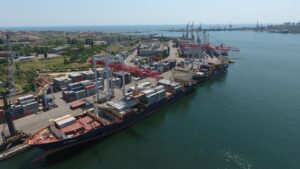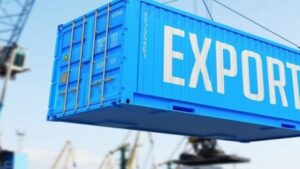
The total tonnage of grain and other food products exported from three Ukrainian ports as part of the Black Sea Grain Initiative reached 1 million 766.53 thousand tons on September 2, the Joint Coordination Center (JCC) reported.
“A total of 160 flights are allowed: 86 inbound and 74 outbound,” his summary emphasizes.
In particular, on September 2, the SCC authorized the movement of eight vessels carrying a total of 196.29 thousand tons of agricultural products on Saturday.
Among them from the “Southern” port: MAINA in Tarragona (Spain) with 56.5 thousand tons of corn, CANOPUS in Jawaharlal Nehru (India) with 42 thousand tons of sunflower oil, SEA DOLPHIN in Amsterdam (Netherlands) with 31.1 thousand tons, LADY PERLA in Porto Marghera (Italy) with 20.5 thousand tons of corn.
From the port of “Chornomorsk”: BC CALLISTO to Damietta (Egypt) with 31.4 thousand tons of wheat, LADY EVA in Patras (Greece) with 6.12 thousand tons of wheat, SEALOCK to Mersin (Turkey) with 2.07 thousand tons. tons tons of peas, as well as SARA from Odesa to Tekirdag (Turkey) with 6.6 thousand tons.
Two more vessels whose planned departure on Friday was postponed are also expected to depart on Saturday-Sunday: MUBARIZ IBRAHIMOV from Odesa to Tekirdag (Turkey) with 6.6 thousand tons of sunflower oil and NORD VIRGO from “Pivdenny” to Juan (China) ) from 62.34 thousand tons of corn.
In addition, the SCC completed eight inspections of inbound vessels on September 2, and has nine inspections planned for Saturday: six inbound vessels and three outbound.
As reported, on July 22 in Istanbul, at the suggestion of the UN, Ukraine, Turkey and UN Secretary General Antonio Guterres signed an initiative on the safe transportation of grain and food products from the Ukrainian ports of Odesa, Chornomorsk and Pivdenny.

Export of goods from Ukraine in August increased by 13.9% compared to July to $3.363 billion, while imports decreased by 2.3% to $4.416 billion, the Ministry of Economy reported on Friday.
According to him, as a result, the negative balance of Ukraine’s foreign trade in goods last month decreased to $1.053 billion from $1.569 billion in July and $1.549 billion in June.
“The growth in exports is associated with the partial unblocking of the ports of Greater Odessa. This made it possible to significantly increase the volume of exports of Ukrainian goods. As a result, transportation by sea increased by 85% and amounted to almost 2.9 million tons,” the Ministry of Economy noted.
It indicated that in physical terms, in August 2022, the volume of Ukrainian exports increased by 25%, to 7.296 million tons, while imports decreased by 1%, to 1.961 million tons.
According to the Ministry of Economy, Ukraine exported more than 3 million tons of goods by rail, and 1.36 million tons by road.
At the same time, exporters receive the largest revenue from goods exported by road – $1.48 billion, sea cargo cost $995 million, and rail cargo – $788 million.
“Ukraine relies on the export model of economic growth. Before the full-scale war, our exports amounted to 35% of GDP. The goal of the Government and the Ministry of Economy is to raise it to 50%. 75% of exports should be finished goods and services,” the words of the First Vice -Prime Minister – Minister of Economy Yulia Sviridenko.
The leaders in terms of export value in August were, in particular, sunflower oil – $443 million and corn – $347 million, whose export volumes increased by 30%, to 366 thousand tons and by 31%, to 1.5 million tons, respectively, while export of sunflower seeds amounted to $71 million.
In addition, the list of leaders includes rapeseed – $305 million, including exported 665 thousand tons of this crop of the new crop, and wheat – $213 million, the export of which in August increased 2.3 times compared to July, to 880 thousand tons.
Last month, soybean exports jumped by 30% to 148,000 tons, and in monetary terms to $62 million, while revenue from electricity exports doubled to $73 million, which was the result of the successful integration of the Ukrainian energy sector into ENTSO-E, an energy system of the European Union.
“It is important that confectionery processing products demonstrate a stable upward trend: bakery +19.4%, sugar +9.1%, chocolate +25%,” the Ministry of Economy added, without specifying specific indicators.
At the same time, ore exports fell to 1.4 million tons, and in monetary terms – to $172 million, cable products – by 9.8%, to $89 million, poultry meat – to $67 million.

The income of NPC Ukrenergo from the sale of the interstate section for the export of electricity to Romania and Slovakia from June 30 to August 31 rose to UAH 2.94 billion.
According to the results of daily auctions held by Ukrenergo in these areas, in the last ten days of August, proceeds from the sale of cross-sections increased by UAH 1.02 billion due to an increase in electricity prices in Europe, which directly affects the price of cross-sections. As a result, exports to Romania for ten days cost UAH 502.1 million, which is 39% higher than in the third week of August, to Slovakia – UAH 519.5 million (63% higher than the average daily cross-sectional cost in the third week of August).
The most expensive was the section on the last day of August – in Romania 56.8 million hryvnia, in Slovakia 59.4 million hryvnia.
On the same date, a new record was also set for the maximum hourly price of a section – UAH 22.1 thousand / MWh in Romania and UAH 23.7 thousand / MWh in Slovakia (previous records were UAH 21.7 thousand, respectively) /MWh and 21.27 thousand UAH/MWh).
According to Energy Reform calculations, the average hourly price of a section for ten days of August amounted to UAH 16.7 thousand / MWh in Romania, and UAH 17.3 thousand / MWh in Slovakia.
According to the Market Operator, as of August 31, the average electricity price on the day-ahead market (DAM) in Romania is EUR684/MWh (in terms of the current euro exchange rate, about UAH 25,000/MWh) , Slovakia – EUR 673 / MWh (about 24.6 thousand UAH / MWh). In Ukraine, the electricity price of the BASE period on DAM is EUR 86/MWh (about UAH 3.14 thousand/MWh).
The most active exporter is the state-owned energy trader AK ECU, which entered the market on August 19. Of the possible 3,000 MWh per day, the company buys a section for export via the Romanian direction of 1488 MWh per day (62 MW per hour of the day), along the Slovak route – for the supply of 1512 MWh per day (63 MW per hour).
The second largest exporter in both directions remains DTEK Zakhidenergo, which bought out during this period mainly a cross-section for deliveries from 1,000,000 MWh to 1,200 MWh.
Most of the remnants of the cross-section were bought out by Latest Technologies 3000, Ukr Gas Resource, Electric Trading Group, and DE Trading. Many companies participated in auctions without results.
The state-owned PJSC “Ukrhydroenergo” continued to buy a section of 100 MW on a flat schedule for the supply of electricity to Moldova (a total of 2400 MWh per day).
The section to Poland continues to buy back at daily auctions in addition to the 147 MW of capacity bought out at the monthly auction of DTEK Zakhidenergo – on August 22-31 at 63 MW every hour (1512 MWh per day),
Sections from Slovakia, Romania and Moldova at daily auctions for the last ten days of August traditionally remained not redeemed.
The section price at all auctions, except for exports to Romania and Slovakia, is 0 UAH/MWh.
As reported, on July 28, ENTSO-E increased its capacity for export to Romania and Slovakia to 250 MW. Ukrenergo held a daily auction on the same day, dividing the capacity equally. A month earlier, commercial exports began with 100 MW to Romania, from July 7 they were shared with Slovakia for 50 MW.
According to the Ministry of Energy, technically, Ukraine can already export at a capacity of 1.5-1.7 thousand MW and expects an increase in exports over time.
The head of Ukrenergo, Volodymyr Kudrytsky, noted that he expects a decision to increase exports from the Europeans on September 2.

In January-July 2022, Ukraine increased its revenue from electricity exports by 1.5 times (by $70.026 million) compared to the same period in 2021, to $205.638 million, according to the State Customs Service.
According to the Interfax-Ukraine agency, over seven months electricity was supplied to Poland for $65.056 million, Slovakia – for $48.968 million, Hungary – for $40.408 million, other countries – for $51.206 million.
In July this year, electricity export revenue amounted to $35.64 million compared to $27.373 million in June 2021.
In addition, in January-July 2022, Ukraine imported electricity for $107.931 million against $59.058 million for the same period last year. Including from Belarus – by $100.414 million (in January-February), Belgium – by $4.778 million, Moldova – by $1.041 million, other countries – by $1.698 million.
Last month, Ukraine imported electricity for $5.816 million compared to $0.461 million in July 2021.
As reported, Ukraine in 2021 reduced its revenue from electricity exports by 8.5% (by $23.89 million) compared to 2020, to $256.941 million. In addition, Ukraine imported electricity by $87.345 million in 2021 against $131.605 million for 2020th.
Ukraine in 2021 reduced the export of electricity by 26.5% (by 1 billion 258.7 million kWh) compared to 2020 – to 3 billion 495.4 million kWh, import – by 25.9% (by 591.3 million kWh), up to 1 billion 693.6 million kWh.

The state will partially compensate exporters for interest accrued and paid this year on loans insured by the Export Credit Agency (ECA), the website of the Ministry of Economy reported on Wednesday.
The corresponding decision was made by the Cabinet of Ministers at a meeting on August 23.
It is indicated that the state will partially compensate the rate on export credits, which are taken for a period of two to 12 years and amount to no more than 85% of the amount of the foreign economic contract.
Such loans should be used to replenish working capital, purchase equipment, fulfill the terms of a foreign economic contract, and build and reconstruct production facilities.
It is noted that the borrower must be a FOP or a legal entity registered on the territory of Ukraine (except for the temporarily occupied territories), not have open bankruptcy cases and not be in the process of liquidation.
The Ministry clarified that if the borrower violates the terms of interest payment for more than 15 days, compensation will be temporarily suspended.

Mining enterprises of Ukraine in January-July this year reduced the export of iron ore raw materials (IORM) in physical terms by 28.8% compared to the same period last year – up to 18 million 571.940 thousand tons.
According to statistics released by the State Customs Service (STS), over the specified period, foreign exchange earnings from the export of iron ore decreased by 49.8% – to $ 2 billion 357.073 million.
Iron ore was exported mainly to Slovakia (19.80% of deliveries in monetary terms), China (16.07%) and Poland (15.6%).
During the reporting period, IORM was imported to Ukraine for $14 thousand in a total volume of 25 tons, while in January-July 2021, iron ore for $130 thousand was imported in a total volume of 1,134 thousand tons. Imports for January-July 2022 were carried out from Britain (78.57%), Italy (14.29%) and the Russian Federation (7.14%).
As reported, Ukraine in 2021 reduced the export of iron ore raw materials (IORM) in physical terms by 4.2% compared to 2020 – up to 44 million 357.727 thousand tons, but increased revenue by 62.8% – up to $6 billion 899.816 million The export of iron ore was carried out mainly to China (41.90% of supplies in monetary terms), the Czech Republic (9.65%) and Poland (7.99%).
Last year, IORM was imported to Ukraine for $184 thousand in a total volume of 1.202 thousand tons, while in 2020 123 tons of iron ore for $75 thousand were imported. Imports for 2021 were carried out from Egypt (55.98%), the Netherlands ( 21.2%) and Poland (7.07%).